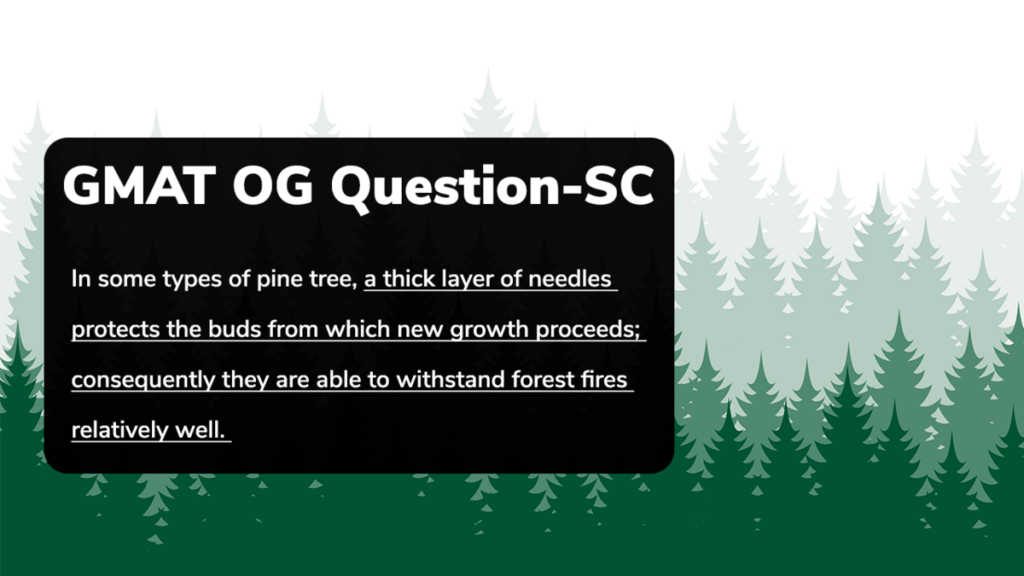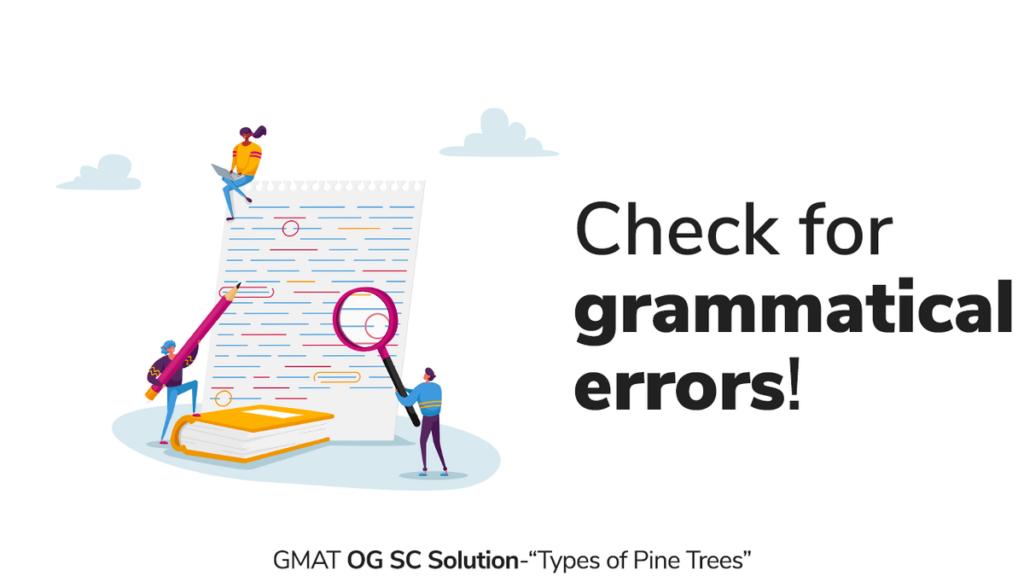In this article, we’ll look at the solution to the 700-level GMAT Official Guide 2022 Sentence Correction question. Here is some general information about this question – In some types of pine tree, a thick layer of needles protects the buds from which new growth proceeds; consequently they are able to withstand forest fires relatively well.
- Difficulty level – Medium
- Most common Incorrect option choice: B, C
- Topics tested – Meaning, modifiers, pronouns, redundancy, subject-verb

OG Question – In some types of pine tree…
In some types of pine tree, a thick layer of needles protects the buds from which new growth proceeds; consequently they are able to withstand forest fires relatively well.
In some types of pine tree… [Video solution]
Here is the video solution for the GMAT OG SC question:
Begin your GMAT preparation with the most reviewed GMAT prep company on GMAT club, which has delivered more 700+ scores than any other GMAT club partner. Achieve GMAT 740+ with our AI driven tools that give you personalized feedback at every step of your GMAT journey. Take our free trial today!
#1 Logical Meaning
This sentence talks about some particular kinds of pine tree, giving us points of information about this tree.
- A thick layer of needles on the tree protects the buds.
- The author then tells us that it is from these buds that new growth comes.
- Because these needles protect the buds and the buds produce new growth, these buds can withstand forest fires pretty well.
Now I will be honest, I did a little back and forth on this third point. Is it that the buds can withstand fire, or the tree can withstand the fire? If we think logically, the needles protect the buds, and the buds produce growth, regenerating the tree. However, it is the buds that withstand the fire. Do they ultimately regenerate the tree? Possibly, but the entire process is not the point here. That subject may be an RC passage in the making!
Thus, the original sentence is logically correct. But are there any errors?
Grammar Check!

What do we check first when we are looking for grammatical errors? Once we have the meaning extracted, we need to go back to the basic foundations of the sentence and check the key building blocks.

- Do the subject-verb pairs agree? Yes, all the subject-verb pairs agree in number and make sense. The verbs properly express factual information about the pine tree being discussed using the simple present tense.
- Are there any pronoun demons at work here? We only have one pronoun in the sentence – “they.” So, what is “they” referring to? Well, let’s go back to the meaning we extracted- “they are able to withstand forest fires.” During our meaning discussion, I admitted I went back and forth between “trees” and “buds,” but logic won in the end, and it is clear per the meaning that it is the “buds” that can withstand fire because they are covered by a thick layer of needles. So, the pronoun logically refers to the “buds.” This usage is excellent because the pronoun is both logically and grammatically correct. Yay!
- Now my modifiers- Is the use of “from which” correct in this context? Yes, indeed, it is correct as used here. It communicates that the growth comes from the buds.
- Is there anything else? Nope, there are no parallelism, comparison, or idiom errors.
- The original sentence looks good!
What Makes Option B So Popular?
A: a thick layer of needles protects the buds from which new growth proceeds; consequently they are able to withstand forest fires relatively well
B: a thick needle layer protects buds from where new growth proceeds, so that they can withstand forest fires relatively well
Option B is the most popular incorrect answer choice. If you landed on this option, you might have faltered for one of the following reasons.
Is there a difference between “thick layer of needles” VS. “thick needle layer?”

Looking at these two expressions, the latter seems more precise, and we know GMAT likes precise, so is this usage correct? Well, there is nothing grammatically incorrect about “thick needle layer” being used. But stop and think, is the meaning communicated the same with both expressions? Which expression conveys more clearly that the layer is made of multiple needles? The first expression, “thick layer of needles,” more accurately gives us the intended meaning that the layer is composed of a lot of needles instead of the layer being of a solid needle.
The difference between “of which” and “from where”. The original sentence uses “of which,” and option B uses “from where”. Are you asking what is the difference between the two? Well, here is a quick lesson!
- Mini-Modifier lesson
“From which” communicates that something comes from a thing or item. The “buds” are the ‘thing’ from which the new growth comes; this modifier makes sense.
“From where” is a modifier consisting of two words saying the same thing- it is like the author rolled doubles here. The words “from” and “where” communicate that something comes from a place or location. So, do we need both? Nope, we would be good with just one. This usage is creating redundancy.
Other Incorrect Options- Quick and Simple
![In some type of pine tree... |[Answer choice analysis]](https://cdn.e-gmat.com/blogs/wp-content/uploads/2021/12/answer-choice-analysis-in-some-type-of-pine-tree-1024x576.png)
The remaining choices are pretty easy to eliminate quickly.
C. a thick layer of needles protect the buds from which new growth proceeds; thus, they are able to withstand relatively well any forest fires
(SV must agree error and why is “any forest fire so far away from “withstand?”)
D. since the buds from which new growth proceeds are protected by a thick needle layer, consequently they can therefore withstand forest fires relatively well
(Can you see the redundancy error here?)
E. because the buds from which new growth proceeds are protected by a thick needle layer, consequently they can therefore withstand forest fires relatively easily as a result
(Hello, redundancy in expressing causation!)
There we have it- understand the meaning, check for errors, and the process of elimination becomes quick and straightforward!
If you are planning to take the GMAT, we can help you with a personalized study plan and give you access to quality online content to prepare. Write to us at acethegmat@e-gmat.com. We are the most reviewed GMAT prep company on gmatclub with more than 2400 reviews and are the only prep company that has delivered more than 700+ scores than any other GMAT club partner. Why don’t you take a free trial and judge for yourself?


![[OG Solution] In some types of pine tree, a thick layer of needles..](https://cdn.e-gmat.com/blogs/wp-content/uploads/2021/11/in-some-types-of-pine-tree-gmat-og-solution.png)








